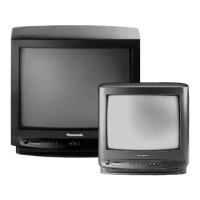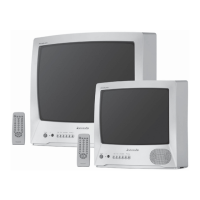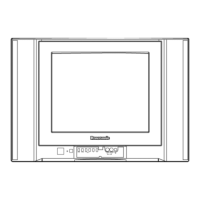Do you have a question about the Panasonic TC-14L3Z and is the answer not in the manual?
Details power requirements (AC 230V, 50Hz) and system compatibility (PAL B&G).
Guidelines for maintaining the TV cabinet and picture tube condition, avoiding certain cleaning agents.
Caution against removing the rear cover due to accessible live internal parts.
Recommendation to disconnect the TV from the power outlet during prolonged periods of non-use.
Identifies buttons and indicators like Power Switch, Preset, Function, Skip, and System on the front panel.
Shows aerial and AV input/output terminals located on the back of the TV set.
Diagram and identification of buttons on the remote control transmitter for operation.
Step-by-step guide for automatic channel scanning across VHF and UHF bands.
Process for manually tuning channels, suitable for areas with few broadcast signals.
Adjusting fine tuning for improved picture and sound quality in areas with poor reception.
Instructions on how to revert a channel's fine tuning to its default state.
Instructions to skip channels that do not receive TV stations, making channel surfing more efficient.
Steps to remove a previously selected channel from the skip list.
Switching between TV broadcast reception and external AV input sources.
Controls for increasing or decreasing the sound level of the TV.
Using buttons to navigate through available TV channels.
Modifying picture and sound settings like Colour, Brightness, and Contrast.
Resets all function settings to their factory default levels.
Choosing the appropriate broadcast system (AUTO, PAL, NTSC) for optimal picture.
Displays current channel and colour system information on screen.
Turning the TV on and off, or putting it into stand-by mode using the remote.
Directly selecting channels from 0-9 using numeric buttons on the remote.
Selecting channels from 10 to 29 using the remote's numeric and special buttons.
Temporarily disabling the TV's audio output by pressing the Mute button.
Scheduling the TV to automatically turn off after a specified period.
Instructions to disable the automatic TV turn-off timer.
Remote buttons used for adjusting sound level and function settings.
Remote buttons for selecting the next or previous TV channel.
Displays current channel and colour system information on screen via remote.
Remote button for switching the TV between broadcast and AV input modes.
Step-by-step guide for opening the cover and inserting batteries into the remote control.
Important safety warnings and guidelines for handling remote control batteries to prevent damage.
Connecting external AV devices like VCRs, cameras, and computers to the TV's input.
Connecting recording equipment to the TV's output terminals for signal recording.
A table correlating common picture/sound problems with potential causes and checks.
Details on electrical input requirements (voltage, frequency) and power usage.
Supported broadcast standards (PAL, NTSC) and channel frequency ranges (VHF, UHF).
Specifications for the screen size, deflection, and maximum audio output power.
Overall physical size (WxDxH) and mass of the television set.











